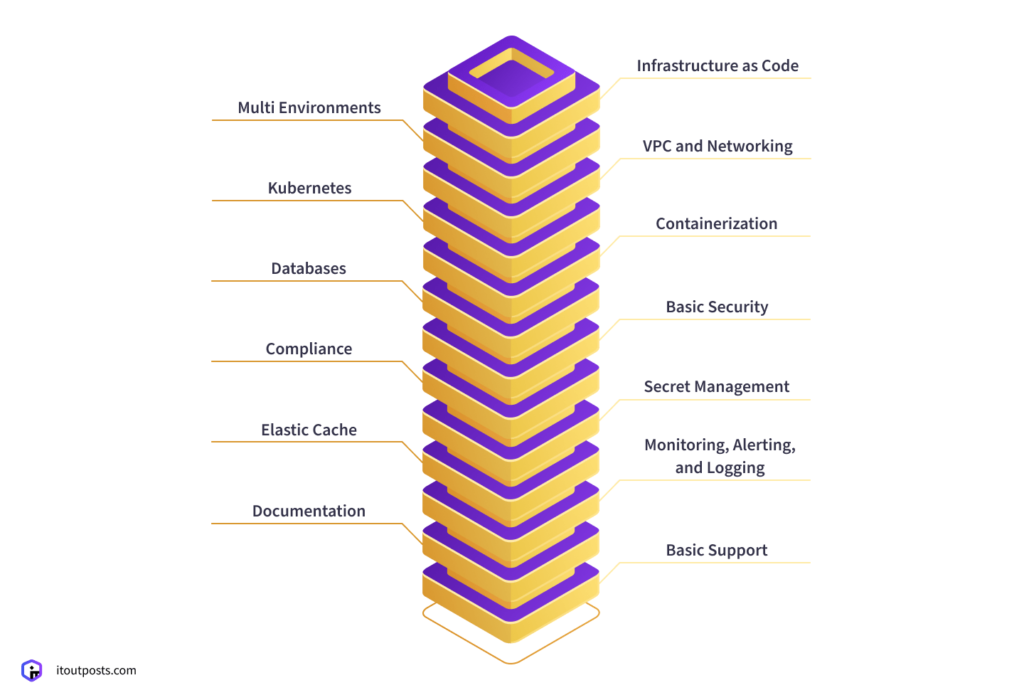Contents
You might not spot it right away, but there’s a big difference between good and great infrastructure. It becomes obvious when your business starts to grow rapidly, when numerous users are all trying to access your system at the same time, or when you’re going to launch in a new area.
Having solid infrastructure is more than just using the latest tools or having massive servers. It’s about making smart decisions that help your business right now while also setting it up for the future.
In this article, we’ll explore what makes certain infrastructure designs stand out. Find out the thirteen basic elements that create infrastructure built for success.

1. Infrastructure as Code
Picture this: you can handle your whole infrastructure setup using just a handful of files. That’s what infrastructure as code (IaC) brings to the table. Instead of clicking through control panels or typing out commands, you just write down your entire system in code.
This method cuts out human mistakes. Every server, network, and security rule gets set up the same way every time. Plus, version control becomes simple. Your teams can see every change, revert if needed, and collaborate without stepping on each other’s toes.
The best part? When you want a new environment, just run the code. It only takes minutes. Terraform is the leading tool for IaC, and it keeps you on top of your infrastructure’s current state while showing exactly what needs changing to reach your target setup.
2. Multi Environments
Every successful system needs different spaces for development, testing, and real user traffic. Therefore, it’s a must to create multiple environments that separate these areas.
A development environment serves as a playground for developers to try things out and break them without any consequences. Testing environments mimic the live setup so teams can catch bugs before they impact real users.
Staging areas are the last stop before going live. They use data and settings similar to production to check that everything works as it should. Finally, production environments are where the system lives. Each environment calls for its own resources, security measures, and access rules, but they should all follow the same basic setup. This ensures that code working in testing will perform the same in production.
3. VPC
A virtual private cloud (VPC) is a secure, private part of the cloud where you can safely run your resources. In your VPC, you can set up different network areas called subnets. Some subnets stay public, while others are private for sensitive components like databases. With a good VPC setup, your resources can communicate with each other easily while staying safe.
4. Kubernetes
Kubernetes gives you full control over your modern applications. It takes away the headaches of managing complex systems by automating critical tasks and making smart decisions.
When your application needs more power, Kubernetes adds resources automatically. But when things get quieter, it scales back to save costs. If any part of your application fails, Kubernetes fixes it, usually before users even realize there’s an issue.
5. Containerization
Containerization is the base that makes the management of modern applications smooth and uniform. It lets you package your applications with everything they require, like libraries, dependencies, and configurations, into lightweight, portable units, or containers.
This implies your application will function identically on a developer’s laptop, within a testing environment, or across various cloud platforms. Containers start up quickly and utilize system resources in an efficient manner, allowing you to deploy updates and adjust workloads without causing slowdowns.
Docker is the most popular tool for building and managing containers. Combined with Kubernetes, containerization ensures scalability, flexibility, and reliability. You receive a unified way to build, ship, and run applications.
6. Database
Poor database performance can stop your whole system in its tracks. No matter how good your code is or how speedy your servers are, if your database has issues, everything slows down.
Modern databases like Amazon RDS, Aurora, and DynamoDB tackle these issues head-on. They can handle many requests while keeping your data safe and ready to go instantly. When there’s a traffic surge, they automatically adjust. And if some hardware goes down, they seamlessly switch to backup systems.
Check out: What is disaster recovery as a service?
7. Basic Security Measures
Being secure online is a must. Even tiny holes in security can cause problems, from data leaks to downtime. Basic security steps help keep your system safe from everyday threats while still being easy for the right people to access.
Firewalls are your go-to guards. They filter network traffic, blocking suspicious requests but letting legitimate users through.
Identity and access management (IAM) is another basic security measure. This is how your system understands who can do what. Everyone gets only the access they need, no more, no less. This way, if one account gets compromised, the damage is kept to a minimum.
8. Compliance
Staying compliant means following specific rules and standards that govern how you handle data and protect your systems. And in the majority of cases, it’s required by law in a specific country. By skipping these requirements, you risk facing hefty fines (sometimes millions of dollars) and losing the trust of your customers.
The rules around compliance differ by industry and region. For instance, financial institutions must meet SOC 2 Type 2 standards, while healthcare organizations follow HIPAA to safeguard patient information. If you do business in Europe, how you collect and process personal data is controlled by GDPR.
Therefore, before you start building a system, it’s critical to understand what compliance requirements apply, particularly to your project, to incorporate compliance into your automation processes from the outset. To make sure every code commit automatically initiates security checks, infrastructure changes leave audit trails, and any policy violations are detected before they even reach production.
9. Secret Management
These days, we deal with a lot of complicated systems, and secrets like API keys, passwords, and certificates require serious protection. Putting them in code or config files is just asking for trouble. One tiny leak can impact your whole setup.
That’s where modern secret management tools come in handy. Services like AWS Secrets Manager and External Secret Operator keep your sensitive data locked up tight and under control.
Moreover, they automatically change credentials, log who access history, and notify your team if anything suspicious happens.
Don’t miss: 10 Ways to Slash Your Cloud Costs
10. ElastiCache
Every time your app needs data, it takes some time. When multiple users are asking for the same data, your database ends up working overtime. This can slow down performance and bother users.
Services like Amazon ElastiCache, backed by Redis or Memcached, serve up data right away to your apps. This means quicker responses and happier users.
But necessary to mention that Redis and Memcached meet different needs. Redis deals with complex data types and has more features, while Memcached focuses on speed and simplicity. However, both work well with most applications.
Discover what Amazon ECS can do for you.
11. Monitoring, Alerting, and Logging
Monitoring your system is vital, just like keeping your eyes open while driving. If something goes wrong, it might be too late by the time you see it. But when you have a solid monitoring setup, you can catch problems before your users even notice.
That’s why you should consider modern tools like Prometheus and Grafana. They watch your system all the time, tracking everything from your server’s health to how your apps are running. Plus, with custom dashboards showing live data, your team can easily spot trends and catch potential issues.
12. Documentation
Great documentation makes complicated systems easy to understand. It pulls the knowledge out of people’s brains and shares it with everyone who needs it. This is more important than most teams think.
Today’s documentation covers all the important parts of your system. It tells you not just what exists but also why certain decisions were made. When new engineers join the team, clear guides help them onboard and get to work much faster. And when things go wrong, good documentation helps teams react properly.
13. Infrastructure Support
Finally, even the best infrastructure still requires ongoing care to stay reliable. Once your systems are up and running, basic support becomes your safety net for the long haul.
Support teams do more than just fix issues. They monitor system health, roll out important updates, and catch potential problems. Regular maintenance keeps everything running smoothly, and security patches help defend against new threats.
Build Your Foundation for Success with IT Outposts!
These essential elements form the backbone of reliable, scalable infrastructure. But knowing what you need and building it right are two different challenges.
IT Outposts, recognized as a top DevOps service provider by Clutch, brings these elements together within our fixed-priced package AMIX Infrastructure. It will take only one month to get an Auto-scalable, Migration-ready, Cost-efficient, Secure, and Stable setup at a reasonable price.
Whether you’re starting from scratch or improving existing systems, we’ll gladly become your trusted tech partners! Expert DevOps support is one click away. Contact us!

I am an IT professional with over 10 years of experience. My career trajectory is closely tied to strategic business development, sales expansion, and the structuring of marketing strategies.
Throughout my journey, I have successfully executed and applied numerous strategic approaches that have driven business growth and fortified competitive positions. An integral part of my experience lies in effective business process management, which, in turn, facilitated the adept coordination of cross-functional teams and the attainment of remarkable outcomes.
I take pride in my contributions to the IT sector’s advancement and look forward to exchanging experiences and ideas with professionals who share my passion for innovation and success.